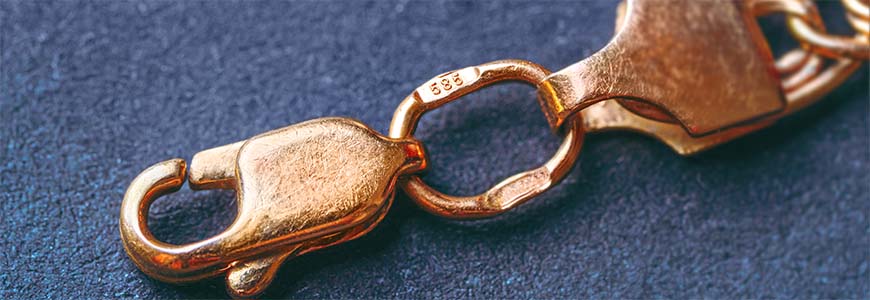
You’re examining your beautiful gold jewelry or browsing gold pieces at a jewelry store when you notice something you’ve never seen before: 585 stamped on a gold piece. Typically tucked away in an inconspicuous location on jewelry such as the inside of a ring band or on a necklace clasp, this jewelry marking provides key information you may have never considered before. Learn what this mysterious 585 marking signifies, how the price of 585 gold measures up and the different colors of 585 gold available.
What Does 585 Stamped on Gold Jewelry Mean?
The 585 stamp found on various types of gold jewelry can be mistaken for many things. You may have thought it was a model number, product code, size measurement (such as ring size or chain length) or a manufacturer's mark. Instead, the number 585 is an indicator of the purity of gold used to make this particular piece of jewelry. A piece of gold containing this marking means it is a gold alloy (not 100% pure gold) that is 58.5% gold and 41.5% other metals, such as copper, silver or nickel.
585 gold is technically the same thing as 14K gold, just represented differently. Jewelry marked as 14K uses the carat system, where 24K represents pure gold. Therefore, 14K means that 14 parts (of the 24 parts) are gold - 14/24 = 58.3%. So why isn’t the jewelry stamped with 583 instead of 585? Great catch! For all intents and purposes, 583 and 585 are used interchangeably in the world of gold purity. Because some gold manufacturers (starting as a European trend) mix their alloys to have a slightly higher gold purity than 14K, the resulting purity nets out to closer to 58.5% gold, resulting in this 585 marking. Jewelry marked with 585 utilizes the millesimal system, where the purity is expressed in parts per thousand. 585 means 585/1000 parts of gold. Some jewelry is marked with a 583 hallmark, which still represents 14K gold.
Price of 585 Gold
Given that 585 gold contains a bit more gold than standard 14k gold, it makes sense that 585 gold may cost more than other similar gold pieces (all other factors being equal). Here are some things to know about the expected price of 585 gold compared to other kinds of gold:
- 585 (14K) gold jewelry tends to be a bit more expensive than lower-purity gold jewelry like 10K gold, which contains a higher percentage of other precious metals like copper, nickel or palladium.
- In contrast, 750 (18K) and pure (24K) gold jewelry may be more expensive due to their higher percentage of gold.
- NOTE: Other factors, including design and craftsmanship, brand reputation and the presence of gemstones, can impact the price of jewelry marked as 585 gold.
Also, when shopping for gold jewelry stamped with 585, you should ask for specific information about any jewelry you intend to purchase. Gold-plated or gold-filled jewelry (created by taking a less expensive base metal and plating it with 585 gold) is different from gold jewelry made from 585 gold throughout. Gold-plated and gold-filled jewelry can be wonderful options but you should expect them to be less expensive as they contain less gold and a less expensive base metal.
Colors of 585 Gold
Like most gold jewelry, 585 gold is available in several colors, including white, yellow, and rose gold. While all varieties of 585 gold contain 58.5% gold, the metal comprising an additional 41.5% of the metal alloy determines its final colors.
- 585 gold alloys utilizing nickel, palladium or silver result in white gold.
- Gold mixed with copper and zinc makes yellow gold.
- Rose gold is also an alloy containing copper (a reddish metal). However, the percentage of copper used in rose gold is higher than in yellow gold (i.e., meaning there’s more red added), giving it that rosy, pink color.
Think back to elementary school art class. It’s like taking gold paint and mixing in colors: white or silver creates a lighter, whiter gold. A little white mixed with red creates a warmer yellow gold. And a higher proportion of red creates an even warmer, more pink-looking gold.
Shopping for 585 Gold: Other Gold Jewelry Markings and Things to Consider
While shopping for jewelry or browsing through your jewelry box, you may have encountered other markings aside from 585 (and 14K). A whole array of gold jewelry markings exist, including “GP” for “gold-plated,” “GF” for “gold-filled” and “750” for gold jewelry containing 75% pure gold (18K gold).
Other gold markings may be used to express where a piece of gold jewelry came from, such as “BIS,” meaning its purity has been tested and certified in India (the Bureau of Indian Standards), or a seagull symbol, meaning the piece has been identified as gold in Egypt. You may also find other markings, including the year the jewelry piece was created, on a jewelry piece. Additionally, a marking of "P" on gold jewelry stands for "plump," meaning the gold purity listed on the jewelry is exact and not an estimate (i.e., a stamp of “10KP” means that the piece contains exactly 41.7% gold).
Keep in mind that not all gold jewelry containing 58.5% gold will be marked with a “585.” Some jewelry created by private jewelers and older jewelry (before legal marking requirements were established) may not include a gold purity hallmark. If you believe your gold jewelry is 585 gold but want confirmation, consider these gold tests or contact a reputable jeweler to find out for sure.
Keep Your Gold Protected with Jewelers Mutual
Whether your gold jewelry is marked with a 585 or some other stamp, it’s a good idea to protect it with a personal jewelry insurance policy from Jewelers Mutual. It’s an affordable option that covers loss, damage and disappearances. You can check your rate by clicking the button below.
